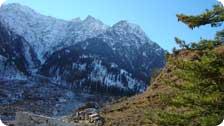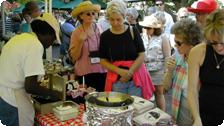by Swapna Dutta
I had always wanted to visit Nainital, a popular
summer retreat in north India. Located in the state
of Uttaranchal at an altitude of 1,938 meters, it was
not too far from Delhi where I lived. So when an
official job required my presence there I jumped at
the chance.
Though said to be uncomfortably crowded
during the tourist season, when I landed up there
(some weeks before the season commenced) the place was
as tranquil as a heart could wish. The lake, unruffled
except for a few rowing boats, was magnificent in its
green splendour, reflecting the tall trees all around
and the weeping willows touching the still waters. The
blue-grey mountain range surrounding it was
resplendent with laburnum, gulmohur, jacaranda and
silver oak. To me what seemed most appealing was the
hushed silence after the noise of Delhi.
The concept of developing “hill stations” came from
the British when they came to India. As they sought
refuge in the hills during the hot summer months, some
of them decided to build colonies where they could
escape from the heat and dust of the plains. Nainital,
however, has a mythological legend about its creation
long before it was made into a popular resort.
The story goes that when goddess Parvati wedded Lord
Shiva despite her father’s disapproval, the latter did
not call her for an important religious ritual.
Parvati went there uninvited but when her father
abused Lord Shiva, Parvati, unable to bear the pain,
dropped down dead.
An enraged Shiva broke out into a
wild dance during which Parvati’s body got severed
into pieces and scattered all over the earth. Her eyes
were supposed to have fallen in Nainital and the place
turned into a lake. Hence the name Naini tal (the eye
lake). There is a temple dedicated to Naina Devi (one
of Parvati’s names) on the bank of the lake which I
visited that evening.
The more recent story about how the “hill station” of
Nainital came to be built is interesting too. A quiet
village tucked away among the hills, there were hardly
any roads except for rough tracks. In 1839 a British
businessman named Barron lost his way while traveling
in the region and is said to have “stumbled upon a
large and beautiful lake hidden in the valley of the
Gagar range where only local herdsmen lived.” This is
how he describes the place in his memoirs:
“An undulating lawn…interspersed with occasional
clumps of oak, cypress and other beautiful trees,
continues from the margin of the lake for upwards of a
mile up to the base of a magnificent mountain standing
at the further extreme of this vast amphitheatre. The
sides of the lake are also bounded by special hills
and peaks which are thickly wooded, down to the
water’s edge.”
Barron decided to give up his sugar business and build
a small colony for Europeans on the lakeside—a
settlement later destined to become one of the
best-loved hill stations of India. But it was not easy
to acquire land just there. The local people who still
considered the lake to be sacred because it held the
eyes of Parvati had no desire to give up their
homeland to a foreigner.
So Barron resorted to a trick
to get hold of the land. The land around the lake
belonged to one Nar Singh. Barron made friends with
him and rowed him to the middle of the lake, more than
150 meters deep, and told him that unless he
surrendered his entire property, he would throw him
in. A terrified Nar Singh is said to have signed off
his claim to the land in Barron’s pocket book on the
rocking boat.
Barron built his own home, Pilgrim Cottage, by the lake
soon after. Other Europeans followed. By 1845 there
were several houses there. Before long there was an
army cantonment, a church, a hospital and a club
house. The holiday bungalows became a permanent
township. The town centered round a level stretch
called the “Flats” which served as a parade ground.
The Sunday morning congregation gathered there after
church with the military band entertaining the
residents and visitors in the evening. The Flats, a
familiar sight in the Hindi films of the 1960s
continues to be the centre of activities even now.
Though there were no bands playing when I passed by, I
saw crowds of young people playing games and enjoying
themselves.
I had also been particularly keen to visit Nainital
because of Jim Corbett, born there in 1875. He had
spent his youth tramping the local forest trails and
mountain ranges, shooting several man-eaters. A poorly
paid railway employee, Corbett often helped the
impoverished village folks with money and enjoyed a
close rapport with them. A local youth pointed out
Gurney House, his summer home, to me. The locals still
remember him with reverence.
The lake being the main attraction of Nainital,
boating and yachting were favourite pastimes during
the British era. The Boat Club was a particularly
elite set-up where even Jim Corbett, despite being
British, was refused membership because he was merely
the son of a postmaster, not grand enough to qualify
as member. My local guide told me that the Kingfisher
Yachting Competition held during the third week of
June every year attracts a lot of tourists even now. I
particularly enjoyed my solitary boat ride on the lake
although I shuddered when I remembered that the lake
was supposed to be more than 150 feet deep!
Once my official work was done I went off to check out
some of the local sights: the Cheena Peak, the
Botanical Garden, St. John’s Church, one of the oldest
buildings in Nainital, the British Cemetery and the
vintage point of “Dorothy’s Seat” built by an
Englishman named Kellet in memory of his wife.
I took the ropeway from the Mall to reach the View Point from
where I not only got a panoramic view of the city but
also a glimpse of the spectacular Himalayan snow range
and the Tibetan borders. Luckily there were binoculars
for hire which made it possible. Unfortunately I
could not make it to the Hanumangarh temple, said to
be a wonderful place for viewing the sunset. Other
places close to Nainital include Bhim Tal and the
Naukuchia Tal, both of them beautiful lakes.
It was time to go souvenir-hunting. There were
attractive handloom products displayed at the shops
and also local woolens, shawls and jerseys, known
for their warmth. But what I liked best were the
candles made locally. There was a breathtaking variety
of them in captivating colours and delightful designs
from which I picked several.
And then I decided it was time to call it a day.
Walking along the road by the lake I saw the setting
sun touch the emerald waters with red and gold. The
myriad shades of green foliage grew darker matching
the growing darkness of the sky. It was a
breathtakingly beautiful sight! I realized that it was
during moments like these that one feels really close
to nature and being alone does not necessarily mean
being lonely.
* * * *
How to get there:
Air: The nearest airport is at Pantnagar, 71 km away.
There are regular flights from Delhi.
Rail: Kathgodam is the nearest railway station, 35 km
away. One can reach there from Delhi, Kolkata, Agra
and Lucknow.
Road: Nainital is connected by road to national and
state highways. There are regular and luxury buses
from Delhi. Taxis are also available.
Where to stay:
There are several luxury hotels (including The Naini
Retreat and Manu Maharani), deluxe hotels (including
Hotel Alka, Elphinetone Hotel and Vikram vintage Inn)
and budget hotels (such as James Cook’s Cabins).
About the Author:
Swapna Dutta is a freelance writer from India who has been writing for the last three decades and
has more than 40 titles to her credit, including
translations. She has translated
poems, novels and short stories from mainstream
literature, and she has written for all major national dailies: Times
of India, Hindustan Times, Indian Express, The Statesman, The
Telegraph, as well as magazines,
both in India and abroad.
Her stories for children have
appeared in the U.S (Cricket) and Australia (The
School Magazine)and in Children’s World, Target,
Tinkle, Chatterbox, Nandan and Tele-kids in India. Although
generally considered a children’s writer because of her award-winning
books, she also writes for the adult reader on travel,
history, health, nutrition and food. She is a traveler and has spent a great deal of time in
Europe.







